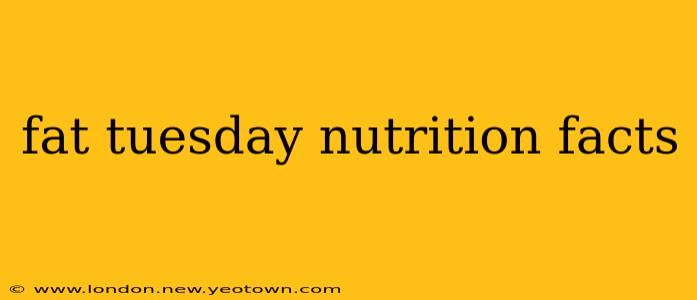Ah, Fat Tuesday! The day of indulgence before the somber reflection of Lent. It's a time for vibrant parades, festive music, and of course, a culinary explosion of rich, decadent treats. But amidst the fun and revelry, it's easy to lose sight of what we're actually consuming. Let's embark on a delicious deep dive into the nutritional facts behind those Fat Tuesday favorites, armed with knowledge to enjoy responsibly.
What are the typical Fat Tuesday foods?
The culinary landscape of Fat Tuesday varies regionally, but some common threads weave through the celebrations. Think of the iconic king cake, its sugary sweetness a siren's call. Then there are the beignets, puffy pillows of fried dough, often dusted generously with powdered sugar. And let's not forget the rich, creamy fillings of various pastries and the often-substantial meals enjoyed throughout the day. These treats, while undeniably delicious, are generally high in calories, fat, and sugar.
How many calories are in a typical Fat Tuesday meal?
This is tricky to pinpoint precisely. A "typical" Fat Tuesday meal is subjective and varies greatly depending on individual choices. However, a realistic estimate might include:
- King Cake Slice: Around 300-500 calories, depending on size and ingredients. Some contain significant amounts of butter, sugar, and even cream cheese fillings.
- Beignets (3): Easily 400-600 calories, given their fried nature and powdered sugar coating.
- Other Sweets/Snacks: This could add hundreds more calories, depending on choices.
Adding a substantial lunch or dinner to the mix means a single Fat Tuesday celebration could easily surpass 2000 calories, significantly exceeding the daily recommended intake for many.
Are Fat Tuesday foods healthy?
Let's be honest: most traditional Fat Tuesday foods are not considered "healthy" in the strictest sense. They're often high in saturated fats, trans fats (from frying), added sugars, and refined carbohydrates. These contribute to weight gain, increased cholesterol levels, and other health concerns if consumed regularly and in excess. However, moderation is key. Enjoying a small portion of these treats as part of a balanced diet isn't necessarily detrimental.
What are some healthier alternatives for Fat Tuesday treats?
While embracing the full Fat Tuesday experience is part of the fun, there are ways to make healthier choices:
- Portion Control: Instead of a large slice of king cake, opt for a smaller portion. Share with friends!
- Homemade Options: Consider making some of the treats yourself, allowing you to control ingredients and reduce the amount of added sugar and unhealthy fats.
- Fruit-Based Desserts: Introduce some lighter, fruit-based desserts to balance out the richer options.
- Balance Your Day: If you know you'll be indulging, make conscious efforts to eat lighter meals throughout the day.
How can I enjoy Fat Tuesday without completely derailing my diet?
The key is mindful consumption. It's about savoring the experience, not overdoing it. Plan your indulgence. Choose one or two of your favorite treats, savor each bite slowly, and enjoy the festive atmosphere. Don't beat yourself up if you overindulge a little; just get back on track with healthy eating habits the next day.
Conclusion:
Fat Tuesday is a celebration of indulgence, a delicious break from routine. Understanding the nutritional facts empowers us to enjoy the festivities responsibly. With a little planning and mindful choices, you can experience the joy of Fat Tuesday without significantly impacting your health goals. So go forth, celebrate, and enjoy! But remember, moderation is the name of the game.

